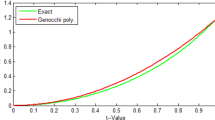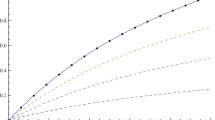Abstract
A new one-step hybrid block method with third derivatives and optimized features aimed at solving the classical one-dimensional Bratu’s and Reactor design problems is developed. The development of the new method considers three intermediate points that are properly chosen through the optimization of the local truncation errors corresponding to the main formulas to approximate the solution and the first derivative at the end point of the block, and another approximation of the solution at an intermediate point. The convergence analysis and the order of the proposed method are analyzed. Some specific problems are solved to demonstrate the efficiency and feasibility of the technique adopted. The numerical results provided through the implementation of the scheme are very much closer to the exact solutions and are found favorably compared with different methods in the available literature.





Similar content being viewed by others
References
Abd-el-Malek MB, Abdelrazek A, Ghazy M, Gamal G (2019) A modified perturbation solution to the one-dimensional Bratu problem. Appl Math Comput 354:296–304
Boyd JP (2001) Chebyshev and Fourier spectral methods. Courier Corporation, Chelmsford
Buckmire R (2004) Application of a Mickens finite-difference scheme to the cylindrical Bratu-Gelfand problem. Numer Methods Partial Diff Equ 20:327–337
Caglar H, Caglar N, Ozer M, Valaristos A, Anagnostopoulos AN (2010) B-spline method for solving Bratu’s problem. Int J Comput Math 87(8):1885–1891
Canuto C, Hussaini MY, Quarteroni A, Zang TA (1988) Spectral methods in fluid dynamics. Springer, New York
Chawla M, Subramanian R, Sathi HL (1988) A fourth order method for a singular two-point boundary value problem. BIT 28:88–97
Das N, Singh R, Wazwaz AM, Kumar J (2016) An algorithm based on the variational iteration technique for the Bratu-type and the Lane-Emden problems. J Math Chem 54(2):527–551
Gray BF (1978) The distribution of heat sources in the human head-theoretical consideration. J Theor Biol 71:255–263
Jacobsen J, Schmitt K (2002) The Liouville-Bratu-Gelfand problem for radial operators. J Diff Equ 184:283–298
Kafri HQ, Khuri SA (2016) Bratus problem: a novel approach using fixed-point iterations and Greens functions. Comput Phys Commun 198:97–104
Khuri SA (2004) A new approach to Bratu’s problem. Appl Math Comput 147:131–136
Mohsen A (2014) A simple solution of the Bratu problem. Comput Math Appl 67:26–33
Na TY (1979) Computational methods in engineering boundary value problems. Academic Press, New York, pp 181–184
Pandey PK (2010) Finite difference method for a second-order ordinary differential equation with a boundary condition of the third kind. Comput Methods Appl Math 10(1):109–116
Ramos H, Rufai MA (2019a) Numerical solution of boundary value problems by using an optimized two-step block method. Numer Algorithms. https://doi.org/10.1007/s11075-019-00753-3
Ramos H, Rufai MA (2019b) A third-derivative two-step block Falkner-type method for solving general second-order boundary-value systems. Math Comput Simul 165:139–155
Roul P, Madduri H (2019) An optimal iterative algorithm for solving Bratu-type problems. J Math Chem 57:583–598
Rufai MA, Ramos H (2020) One-step hybrid block method containing third derivatives and improving strategies for solving Bratu’s and Troesch’s problems. Num Math: Theor, Methods Appl 13:946–972
Temimi H (2012) A discontinuous Galerkin finite element method for solving the Troeschs problem. Appl Math Comput 219:521–529
Wan Y, Guo Q, Pan N (2004) Thermo-electro-hydrodynamic model for electro-spinning process. Int J Nonlinear Sci Numer Simul 5:5–8
Wazwaz AM (2005) Adomian decomposition method for a reliable treatment of the Bratu-type equations. Appl Math Comput 166:652–663
Zahoor Raja MA, Samar R, Alaidarous ES, Shivanian E (2016) Bio-inspired computing platform for reliable solution of Bratu-type equations arising in the modeling of electrically conducting solids. Appl Math Model 40(11–12):5964–5977
Author information
Authors and Affiliations
Corresponding author
Additional information
Communicated by Jose Alberto Cuminato.
Publisher's Note
Springer Nature remains neutral with regard to jurisdictional claims in published maps and institutional affiliations.
Rights and permissions
About this article
Cite this article
Rufai, M.A., Ramos, H. Numerical solution of Bratu’s and related problems using a third derivative hybrid block method. Comp. Appl. Math. 39, 322 (2020). https://doi.org/10.1007/s40314-020-01372-8
Received:
Revised:
Accepted:
Published:
DOI: https://doi.org/10.1007/s40314-020-01372-8
Keywords
- Ordinary differential equations
- Hybrid block method
- Bratu’s and reactor design problems
- Boundary-value systems
- Intra-step nodal points
- Optimization strategy




